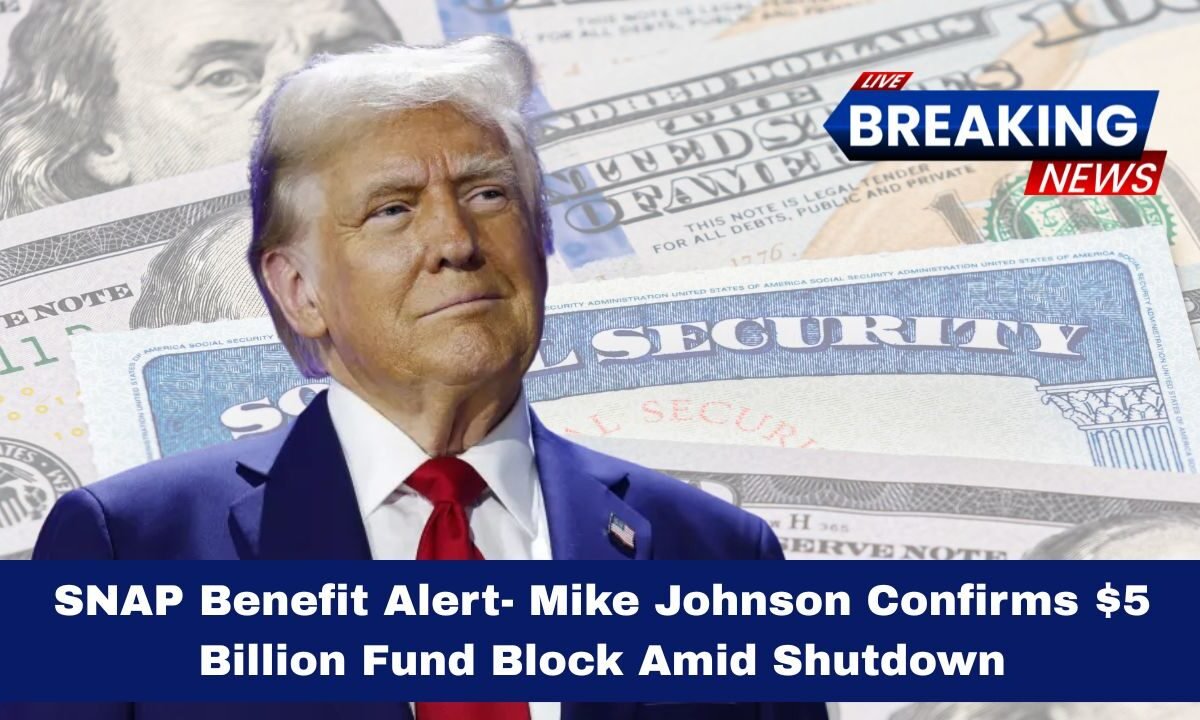Millions of Americans who rely on the Supplemental Nutrition Assistance Program (SNAP) may face uncertainty as the federal government shutdown continues.
On Monday, House Speaker Mike Johnson, a Republican from Louisiana, confirmed that around $5 billion in contingency funds are “not legally available” to cover SNAP benefits.
The statement has raised concerns that millions could lose access to food aid if the shutdown extends into November.
What Mike Johnson Said
Mike Johnson told reporters that the contingency fund cannot be redirected to pay SNAP benefits because it is a finite fund set aside by Congress for emergencies. Using it now, he said, would take away resources from other essential programs such as school meals and infant formula.
“The SNAP benefits are in a unique situation,” Johnson said. “If the funds are transferred from other programs, it immediately pulls money away from child nutrition and other aid programs. It’s a tradeoff.”
He also blamed Democrats for the ongoing shutdown, saying the best way to ensure timely SNAP payments is for them to approve the necessary funding to reopen the government.
Why This Matters
The announcement comes during a tense period as the government shutdown enters its fourth week. SNAP provides monthly payments to nearly 42 million Americans who depend on these benefits to buy groceries and meals.
The risk of benefit delays or interruptions is creating anxiety among low-income families already struggling with inflation and high living costs.
Many families fear that if benefits are not delivered on time, they may have to skip meals or turn to food banks for help. Community organizations are preparing for an increase in food insecurity as the November 1 payment date approaches.
USDA’s Position
According to officials, the contingency fund is meant for emergencies such as natural disasters, not for regular benefit payments during a budget lapse. Federal law restricts the use of these funds unless Congress has already approved the money for the fiscal year.
Because no budget agreement has been reached, the Department of Agriculture cannot legally issue new SNAP payments using those funds.
The department has warned that states will not be reimbursed if they try to use their own funds to cover the shortfall. This puts pressure on both federal and state agencies to find a quick solution before the next payment cycle begins.
Impact on Families
If the shutdown continues, millions of households will face financial strain and food shortages. The uncertainty has already caused concern among SNAP recipients who rely on the monthly deposits to afford basic meals.
A recent survey of benefit users found that many families are already rationing food, skipping meals, or visiting food banks more frequently. For them, even a short delay could be devastating.
Many states are exploring emergency options to temporarily fund benefits, but covering the entire nationwide SNAP program would require billions of dollars that states simply don’t have available.
What Happens Next
Congress has yet to reach a deal to end the shutdown. Some lawmakers have proposed temporary bills to fund essential programs, including SNAP, but no measure has passed so far.
If no funding agreement is reached soon, November SNAP payments may be delayed or suspended.
Johnson and other Republican leaders say Democrats must agree to broader spending reforms before reopening the government, while Democrats argue that food assistance should not be used as a bargaining chip.
With the November 1 deadline approaching, both sides face growing pressure from the public to reach a compromise. Food banks and social service agencies across the country are preparing for a surge in demand if SNAP benefits are disrupted.
| Key Detail | Information |
|---|---|
| Program | Supplemental Nutrition Assistance Program (SNAP) |
| People Affected | About 42 million Americans |
| Contingency Fund | $5 billion (not legally available for regular benefits) |
| Main Issue | Government shutdown halting federal funding |
| Next Payment Date | November 1, 2025 |
| Potential Outcome | Delayed or suspended benefits if no funding is passed |
The situation surrounding SNAP benefits highlights how a government shutdown directly affects millions of families who depend on federal aid to survive. Without congressional action, food assistance could be delayed or stopped altogether in November.
Lawmakers must find a swift resolution to prevent widespread hunger and economic hardship among the nation’s most vulnerable households.
FAQs
What is the SNAP contingency fund?
It’s a special reserve of money created for emergencies like natural disasters, not for regular monthly SNAP payments during a shutdown.
How many people receive SNAP benefits?
Around 42 million Americans, including children, seniors, and people with disabilities, rely on SNAP each month.
When could benefits stop?
If the government shutdown continues without new funding, November 1 is the date when SNAP payments could be delayed or paused.




